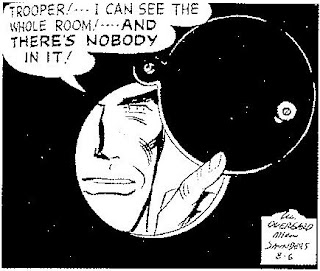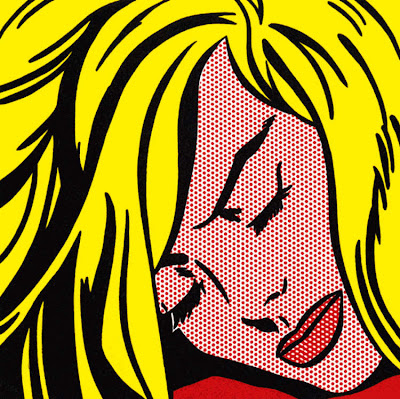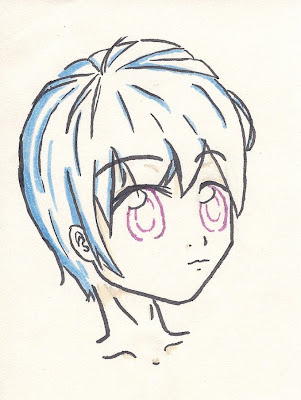American artist Roy Litchenstein is the first comic artist to have made the crossover into the "Art" market.
Big time!
Litchenstein's work, especially his paintings, have shown a sustained upward trend since the 90s.
From his initial success with Big Painting #6, which sold for $60,000 in 1970, to his moderately priced 'VIIP!' comic, which sold for one million dollars in February 2007, to Sleeping Girl, which sold for a whopping $40 mil, Litchenstein successfully captured the intensity of emotions we've come to expect from comic strips.
But how did Litchenstein transfer his tongue-in-cheek humorous compositions from the Pop Art market to the fine art market?
To answer this question, let's first examine his style.
Utilizing the Ben-Day dot process, Litchenstein's artwork bursts out at us with an effect, color and optical illusion that turns our heads toward that iconic 1950s and 60s Pulp comic.
Litchenstein WOW'd us with his hallmark lines and dots composition......which, according to Lawrence Alloway (1983) "were generally interpreted as a putdown of gestural Abstract Expressionism (the disparity between Lichtenstein's neat technique and the hefty swipes of impasted paint)." ~Roy Lichtenstein. Modern Masters Series.
Whether the appeal to Lichenstein's artwork is his style, a nostalgic romp through the 1950s and 60s by successful Baby Boomers who can afford such prices, or something entirely different, can perhaps only be answered by asking a Lichenstein collector why they made the purchase. While some art collectors purchase work based solely on the suggestion of their investment advisors, some more conscientious investors purchase comics because it reminds them of when they were kids.
Roy Lichenstein's paintings not only appeal to investors, but they also appeal to the general public, who pay for museum exhibitions. Curators around the globe, know this, and have been exhibited Lichenstein's artwork along side those of Andy Warhol, Jasper Johns, Jr., and James Rosenquist.
I leave it to you, the reader, to look closely at Litchenstein's work; to determine, for yourself, what it is about these comics that would cause someone to shell out $40 million dollars just to serve as their faithful custodian.
But before you answer this question, think back to your own childhood and ask yourself if there is a special comic you would love to have as your own; a comic character you always related to; an animated friend who greeted you on Saturday mornings; a comic in the Sunday funnies you couldn't wait to get your hands on...
Imagine looking up from your desk or computer right now and seeing that friendly reminder of who you really are deep down inside; who you were as a kid; a reminder of what makes you laugh, what inspires you to relax, and what allows your mind to wander back to the playground of your youth.
Lichtenstein's comics might not personally inspire you, but undeniably, their presence inspires some investors.
What comics, you ask, will be BIG NEWS in the years to come?
I guess it all comes down to who inspired us in the 1970s, and then the 80s, and then the 90s...and so forth. Each generation has their own favorite comics, and each generation eventually finds the funds for FUN!
Big Painting #6 (1965)
Sold for $60,000 in 1970
Kunstsammlung Nordrhein-Westfalen Collection, Düsseldorf
(Exhibited with major works by Pablo Picasso, Henri Matisse, and Piet Mondrian, Jackson Pollock, Frank Stella, Robert Rauschenberg, Jasper Johns, Paul Klee, and Andy Warhol)
"The process of painting is the subject matter in Roy Lichtenstein's Big Painting No. 6. This painting refers to the popular conception of Abstract Expressionist works: their large size broad brushstrokes, drips. But Lichtenstein's painting is all neat and clean. Since the simplification refers to printed color reproductions, Lichtenstein paints in the benday dots of the mechanical process. The affective content of an action painting is replaced by a painted image that, paradoxically, resembles an industrial product."
~Peter Selz, The 1960s: Painting. Art in our Times: A Pictorial History 1890 - 1980.
VIIP!
Sold for $1 million
Hammer price £ 500,000
€758,450, $985,300
Estimate £250,000 - £350,000
Sales date 02-08-2007
Auction house: Christie's
Kiss II
Sold for $6.05 million (£3.8m)
Auction house: Christie's
Purchased by representative of Tokyo's Fujii Gallery
on behalf of an unidentified Japanese Industralist
Happy Tears
Sold for $7.1 million
Auction house: Christies
In the Car, 1 of 2 copies
Sold for $16.2 million
Auction house:
(Larger version: Scottish National Gallery of Modern Art)
Exhibitions: Leo Castelli Gallery (Lichtenstein's 2nd Solo exhibit, Sept. 28 - Oct. 24,1963)
Source: Girls' Romances #78 (September 1961)
Signal Publishing Corp.
Ohhh...Alright (1964)
Sold for $42.6 million (£26.7 million)
Hammer price 38 million
Sales date Nov 2010
Auction house: Christie's
Exhibitions: Las Vegas, Bellagio Gallery of Fine Art; London, Hayward Gallery; Madrid, Museo Nacional Centro de Arte Reina Sofía; San Francisco Museum of Modern Art; New York, Gagosian Gallery
Original source: Secret Hearts #88, June 1963
Arleigh Publishing Corp (now part of D.C. Comics)
I Can See the Whole Room!...and There's Nobody in It! (1961)
Sold for $43 million, double its estimate
Sales date 2011
Auction house: Christie's
Original source: August 6, 1961
Steve Roper cartoon
"Although Litchenstein rendered the composition primarily in black and white he added some notes of colors, such as the field of monochrome color behind the figure. He applied additional color - the flesh tone in the figure's face and hand, and the blue of the pupil - in passages of regularized red and blue dots, respectively. Those dots, of course, make reference to the mechanically printed medium from which Lichtenstein had borrowed his imagery."
~Michael Lobel "Technology Envisioned: Lichtenstein's Monocularity."
Sleeping Girl (1964)
Sold for $44.8 million
Sales date 05-09-2007
Auction house: Sotheby's - Contemporary art sale
Exhibitions: Pasadena Art Museum, Walker Art Center, Museum of Contemporary Art, Los Angeles
A new record for the US Pop Art Icon
Source: Girls' Romances edition #105 (1964)
Published by DC National Comics
Tony Abruzzo
Source:







































.jpg)


